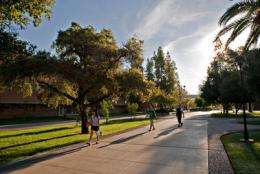SEINet offers desert plant guide online

Imagine that you're going to take a hike in the Superstition Mountains. You love plants, and are always curious about the various bushes, trees and flowers that you encounter in the desert.
Now, instead of snapping a picture of them, then trying to match them up in a Southwestern garden book, you can find out what plants you will encounter before you go - and print photos to take along.
Or, you can tour the Gold Trail or the Maroon Trail at the Arboretum at ASU without leaving your chair.
All you have to do is log into SEINet - the Southwest Environmental Network, which was developed by a team of ASU faculty, including Les Landrum, Peter McCartney, Nancy Grimm, Charles Redman, Timothy Craig and Corinna Gries, starting in 1999, with grants from National Science Foundation.
The site, which has expanded greatly over the years, now includes databases from approximately 20 member institutions and now hosts around 1.6 million specimen records, principally from the Southwestern states and Sonora, Mexico.
Here’s how it works:
First, decide which area you want to learn about, such as the Gold Trail at the Arboretum at ASU. (The Arboretum Trails are reached slightly differently than other collections.)
Then, go to the SEINet website, www.swbiodiversity.org/seinet/index.php , and select “Identification Keys.” Then, select “ASU Arboretum Gold Trail.”
If you want to actually walk the trails, you can go to The Arboretum at ASU’s website and print out trail maps and guides.
Then, after previewing the trail, or printing out photos to take with you, you can take map in hand and wander the Gold Trail to see such plants and trees as a Grizzly Bear cactus, Boojum Tree, Spanish Dagger, Cork Oak, Elephant Tree, Desert Spoons and Pink Dawn.
You can also compare the Silver Oak, Southern Live Oak and Cork Oak, or the San Jose Hesper Palm, Mediterranean Fan Palm, King Palm, Sago Palm, Large Lady Palm, Fishtail Palm, California Fan Palm, Canary Island Date Palm, Senegal Date Palm and the Mexican Fan Palm.
Also in the Identification Keys section, you can look at species lists from the Castle Dome Mountains, Hassayampa River Preserve, Papago Park, Seven Springs, and many more Arizona locations, as well as areas in New Mexico, and the Sonoran Desert Region and even Phoenix metro.
You also can browse the collections of more than 20 herbariums, collections, and botanical gardens, such as the Rocky Mountain Herbarium, New York Botanical Garden, Herbario de la Universidad de Sonora and Grand Canyon National Park.
Once you have selected a collection, you can select a species, then select “map,” and see where that particular plant is located across the Southwest.
The website has many ways to find and use the data, and a good guide to them. On the home page, just click on the Symbiota Help Pages and you’ll automatically be guided through the process.
There’s also a section titled Making Good Use of SEINet offers more information about the site’s features and capabilities.
And, Landrum, herbarium curator for ASU, has written a guide called “Making Good Use of SEINet.”
Though the site is probably more particularly of interest to the botanist or someone familiar with scientific names, it’s an interesting way for the average person to see who else lives in his neighborhood.
Provided by Arizona State University














